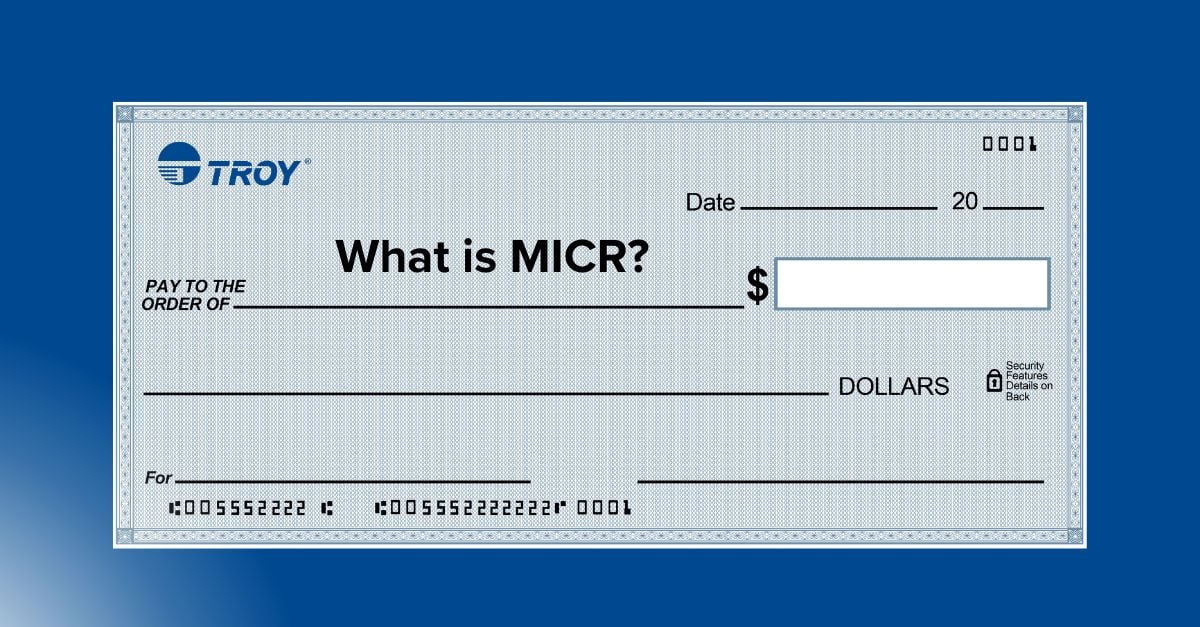What Is MICR (Magnetic Ink Character Recognition)?

We’ve been providing secure check and document printing solutions for over 55 years, and we still get the question: “What Is MICR?“.
Because we are always looking for ways to better educate the public on check printing and security, allow us to break down MICR, why you need it, and the components that make up a total check printing solution.
So, What Is MICR?
MICR stands for Magnetic Ink Character Recognition and is the routing and account numbers printed on a check. To successfully print that line without problems, organizations use a MICR printer, along with MICR ink or toner. This special character font, combined with the magnetic properties of the ink or toner, makes check processing at the bank much faster.
This core characteristic of the check allows data to be captured electronically. It consists of magnetic ink printed characters of a special design known as either E-13B or CMC-7, depending on the region of the world. These special characters are then recognized by high speed magnetic recognition equipment and cleared by a bank. Standards indicating how to print the MICR line were developed as a way to create an industry standard, providing consistency throughout the financial industry.
When checks adhere to financial industry guidelines, it results in a high-quality, negotiable financial document. However, when checks do not comply, they are rejected by the bank and unnecessary processing fees are incurred by both the organization and its customers.
Why You Still Need MICR
Most importantly, the federal reserve requires MICR. Using MICR ink or toner also complies with financial industry and ANSI standards for check printing. By not using this specific toner or ink, your organization runs the risk of checks being rejected by financial institutions. This can lead to your organization incurring unwanted problems, including:
- Lost time and additional labor due to the voiding and reissuing of a payment
- Bank Fees as high as $35 for each returned check
- Unwanted downtime and delays
Data not printed using MICR may not scan properly resulting in clearing issues. This may result in manual entry at the bank leading to unwanted fees.
How Do I Print Using MICR?
Now that you understand what MICR is, the next question is: how do I print checks using MICR? To effectively do so, you’ll need each of the following components. By utilizing all of these, your organization will have a total check printing solution.
MICR Printer
As mentioned, the Federal Reserve sets standards for checks. If a printed check does not meet these standards, it could result in hefty fees. By using a dedicated MICR laser printer for check printing, you ensure you’ll meet all financial industry and ANSI standards for check printing.
To start printing checks, you’re going to need a printer that can print the MICR line. A MICR printer provides your organization with the ability to print a magnetically charged set of numbers at the bottom of the check, also known as the MICR font.
The magnetic ink printer for checks you choose should include:
- Security features that can help protect your organization from the threat of check fraud.
- A MICR font built for the printer you are using. There are one size fits all fonts out there, but these can cause alignment issues.
We recommend using a laser printer for checks that allows you to fine tune the MICR line. The placement of this line is crucial for successful readability. A misalignment can contribute to check rejection and bank fees due to poor readability.
Inks & Toner
Printing on a MICR printer couldn’t be possible without MICR inks and toner. This specialty ink or toner provides the magnetic charge needed for reading the MICR line. While you can use MICR ink or toner in a standard printer, printer manufacturers advise against it. For the best results use a MICR toner in a MICR printer.
When shopping for MICR toner cartridges, you’ll typically find original, remanufactured, or clone cartridges. We highly recommended you use an OEM MICR cartridge when printing checks. OEM toner is formulated to optimize adhesion to the paper stock, meaning:
- Produces consistent character quality
- Deters fraud since it is more difficult to remove from the page
- Provides more reliable performance and consistent yields
Cartridges are also designed to be used once. So, refilling and reusing can comprise the quality and output of a cartridge.
Software
You can’t print checks without some kind of check printing software. By utilizing a check printing software, an organization can streamline the issuing of checks, especially if they are also using blank check stock. This is because the software allows the users to fill in the amount, payee, and other important details – in some instances, even the payer’s signature. This frees up time for authorized signers to focus on tasks most important to your business.
Ideally, you want to make sure your software has some sort of audit trail and reporting. This is going to help you keep track of all of the checks you are printing and who is receiving them. Features like this will help protect your organization from internal fraud threats, including accounts payable fraud.
Blank Check Stock
The final part of the check printing puzzle is check stock. We highly recommend using blank check stock in your check printing workflow. Simply put, implementing blank check stock allows for a more efficient and secure check printing process.
- Eliminate chain of custody or logging
- No more worrying if you printed on sequential numbers
- The need to void preprinted check numbers because of a misprint is no more
For those printing checks for multiple accounts, adopting blank check stock is not only more secure, but it eliminates the need to swap out stocks between customers, since you’re adding the MICR line (bank and routing numbers) at the point of print.
Let’s Talk Security
To increase your protection against check fraud, you’ll want a to use a laser printer for check printing that includes security features. These features could be firmware or additional features that provide added layers of security to the check. Also, you should consider adding locking trays to help safeguard any preprinted or blank check stock.
You also want to use a secure toner in your printer for checks. Secure toners add hidden layers of security to the check. This feature gives you added protection against fraud, especially techniques like chemical alteration. Without using a secure toner, you set yourself up to potentially be frauded.
Need A MICR Printer?
Still have questions about MICR? Good. Our experts are ready to answer any questions you have. Contact us at secure@troygroup.com or (304) 232-0899.

